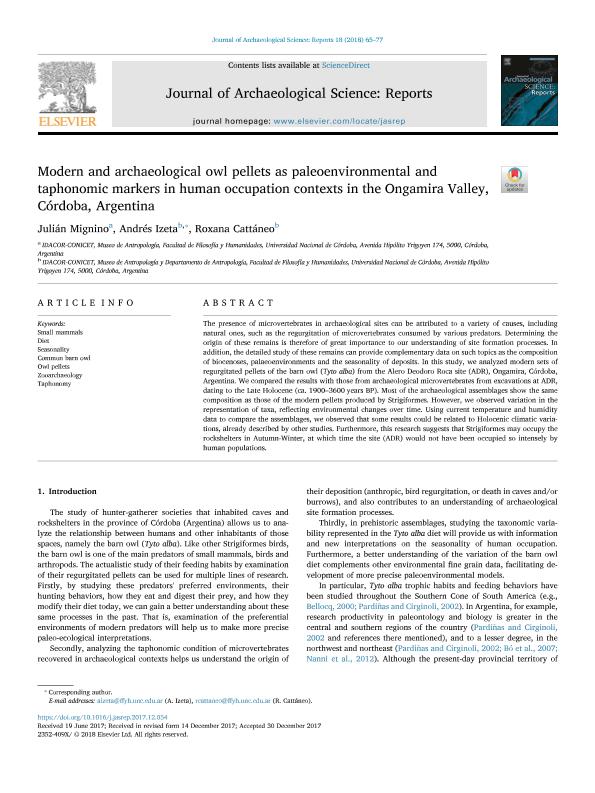Mostrar el registro sencillo del ítem
dc.contributor.author
Mignino, Julian

dc.contributor.author
Izeta, Andres Dario

dc.contributor.author
Cattaneo, Gabriela Roxana

dc.date.available
2019-11-21T16:59:34Z
dc.date.issued
2018-04
dc.identifier.citation
Mignino, Julian; Izeta, Andres Dario; Cattaneo, Gabriela Roxana; Modern and archaeological owl pellets as paleoenvironmental and taphonomic markers in human occupation contexts in the Ongamira Valley, Córdoba, Argentina; Elsevier Ltd; Journal of Archaeological Science: Reports; 18; 4-2018; 65-77
dc.identifier.issn
2352-409X
dc.identifier.uri
http://hdl.handle.net/11336/89422
dc.description.abstract
The presence of microvertebrates in archaeological sites can be attributed to a variety of causes, including natural ones, such as the regurgitation of microvertebrates consumed by various predators. Determining the origin of these remains is therefore of great importance to our understanding of site formation processes. In addition, the detailed study of these remains can provide complementary data on such topics as the composition of biocenoses, palaeoenvironments and the seasonality of deposits. In this study, we analyzed modern sets of regurgitated pellets of the barn owl (Tyto alba) from the Alero Deodoro Roca site (ADR), Ongamira, Córdoba, Argentina. We compared the results with those from archaeological microvertebrates from excavations at ADR, dating to the Late Holocene (ca. 1900–3600 years BP). Most of the archaeological assemblages show the same composition as those of the modern pellets produced by Strigiformes. However, we observed variation in the representation of taxa, reflecting environmental changes over time. Using current temperature and humidity data to compare the assemblages, we observed that some results could be related to Holocenic climatic variations, already described by other studies. Furthermore, this research suggests that Strigiformes may occupy the rockshelters in Autumn-Winter, at which time the site (ADR) would not have been occupied so intensely by human populations.
dc.format
application/pdf
dc.language.iso
eng
dc.publisher
Elsevier Ltd
dc.rights
info:eu-repo/semantics/openAccess
dc.rights.uri
https://creativecommons.org/licenses/by-nc-sa/2.5/ar/
dc.subject
COMMON BARN OWL
dc.subject
DIET
dc.subject
OWL PELLETS
dc.subject
SEASONALITY
dc.subject
SMALL MAMMALS
dc.subject
TAPHONOMY
dc.subject
ZOOARCHAEOLOGY
dc.subject.classification
Arqueología

dc.subject.classification
Historia y Arqueología

dc.subject.classification
HUMANIDADES

dc.title
Modern and archaeological owl pellets as paleoenvironmental and taphonomic markers in human occupation contexts in the Ongamira Valley, Córdoba, Argentina
dc.type
info:eu-repo/semantics/article
dc.type
info:ar-repo/semantics/artículo
dc.type
info:eu-repo/semantics/publishedVersion
dc.date.updated
2019-10-21T19:12:39Z
dc.journal.volume
18
dc.journal.pagination
65-77
dc.journal.pais
Países Bajos

dc.journal.ciudad
Amsterdam
dc.description.fil
Fil: Mignino, Julian. Consejo Nacional de Investigaciones Científicas y Técnicas. Centro Científico Tecnológico Conicet - Córdoba. Instituto de Antropología de Córdoba. Universidad Nacional de Córdoba. Facultad de Filosofía y Humanidades. Instituto de Antropología de Córdoba; Argentina
dc.description.fil
Fil: Izeta, Andres Dario. Consejo Nacional de Investigaciones Científicas y Técnicas. Centro Científico Tecnológico Conicet - Córdoba. Instituto de Antropología de Córdoba. Universidad Nacional de Córdoba. Facultad de Filosofía y Humanidades. Instituto de Antropología de Córdoba; Argentina
dc.description.fil
Fil: Cattaneo, Gabriela Roxana. Consejo Nacional de Investigaciones Científicas y Técnicas. Centro Científico Tecnológico Conicet - Córdoba. Instituto de Antropología de Córdoba. Universidad Nacional de Córdoba. Facultad de Filosofía y Humanidades. Instituto de Antropología de Córdoba; Argentina
dc.journal.title
Journal of Archaeological Science: Reports
dc.relation.alternativeid
info:eu-repo/semantics/altIdentifier/doi/http://dx.doi.org/10.1016/j.jasrep.2017.12.054
dc.relation.alternativeid
info:eu-repo/semantics/altIdentifier/url/https://www.sciencedirect.com/science/article/pii/S2352409X17304364
Archivos asociados
